Top>People>Bringing frozen konjac to the world ―Delicious recipes for losing weight, looking younger and improving skin quality!―
 Index
Index

Sawako Hashizume[profile]
Bringing frozen konjac to the world
―Delicious recipes for losing weight, looking younger and improving skin quality!―
Sawako Hashizume
Cooking Expert for Frozen Konjac, Acupuncturist
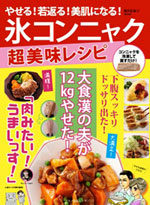
While working as a cooking expert for frozen konjac, I operate an acupuncture and shiatsu massage clinic for women. From some time ago, I have written articles in women’s magazines and health magazines to introduce health management techniques using everyday items. In an interview for a health magazine, I made the following statement: “Diet is the key to good health. My hobby is creating healthy recipes which are delicious and easy to make.” This statement led to the publishing of my first book, Frozen Konjac Diet, in June 2014. The book proposes new ways for eating konjac.
Frozen konjac: A highly versatile ingredient
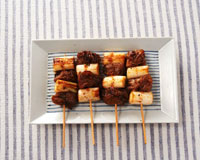
Frozen konjac prepared in the style of yakitori
Frozen konjac is a healthy food which is ever-changing. Depending on the recipe, konjac is cut, frozen, thawed, dried and become meat, fish or even dessert by seasoning. I have introduced recipes which overturn the conventional wisdom that konjac must not be frozen in order to prevent changes in texture. These recipes have gradually attracted attention, and special topic on frozen konjac were broadcast on commercial television a total of four times since autumn 2014. Then, in early 2015, frozen konjac was featured on an NHK news program.
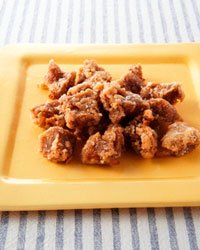
Frozen konjac prepared in the style of fried chicken
Konjac is a low-calorie food which is rich in dietary fiber. It is known as a miracle food that can assist in weight loss, relieve constipation, and even reduce the risk of diabetes, high blood pressure and large intestine cancer. Despite these benefits, Japan is the only country in the world in which konjac is eaten regularly. In Europe and America, konjac is called “Devil’s Tongue,” which gives it a horrible image as a food. It’s true that konjac gives off a strong and unusual odor when removed from its package. The grey surface is slimy and it has a very strange texture. However, frozen konjac removes these characteristics of “Devil’s Tongue” and makes it easier to absorb flavor, thus transforming konjac into a health food which can be used in recipes in countries throughout the world.
Diet is the key to good health
Today, the increasing obesity rate in advanced countries is a serious problem. When rich diets and obesity lead to diabetes, the enormous healthcare costs are said to endanger the very existence of a country. Every day brings a new array of dieting methods, supplements and advanced medical treatment. However, it is the best way to live lively without receiving those treatments. Without a doubt, diet is the key to good health. Even when living in a good environment, constant physical ailments have a negative effect on a person’s emotional and mental state. I believe that an essential element of world peace is ensuring the physical and emotional health of people in advanced nations which lead the world.
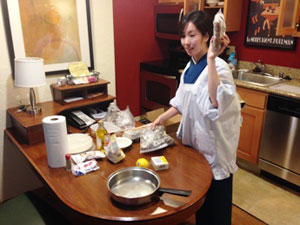
Conducting a demonstration for American-style frozen konjac recipes at a food manufacturer in Los Angeles
Therefore, from last year, I have started working to convey the benefits of frozen konjac to people throughout the world. My efforts started with developing recipes in cooperation with an American food manufacturer. (I am known in America as the “Konnyaku Queen,” http://www.getskinnynoodles.com/Articles.asp?ID=291)![]() . When excluding Hollywood celebrities, etc. who enjoy organic foods and LOHAS, the vast majority of ordinary American households eat food products which lead to obesity and diabetes—macaroni and cheese, hamburgers, cola, and snacks full of white (refined) sugar. It is no easy task to reduce portions or change one’s dietary composition in the quest for good health. In response, I have developed recipes which use frozen konjac as a substitute for people’s dietary composition, keeping volume the same and using delicious flavoring. This allows people to eat a healthy diet without having to refrain from the foods they love.
. When excluding Hollywood celebrities, etc. who enjoy organic foods and LOHAS, the vast majority of ordinary American households eat food products which lead to obesity and diabetes—macaroni and cheese, hamburgers, cola, and snacks full of white (refined) sugar. It is no easy task to reduce portions or change one’s dietary composition in the quest for good health. In response, I have developed recipes which use frozen konjac as a substitute for people’s dietary composition, keeping volume the same and using delicious flavoring. This allows people to eat a healthy diet without having to refrain from the foods they love.
Currently, I am researching lifestyle patterns, food culture and frozen konjac recipes for the United Arab Emirates, which currently has the fifth highest obesity rate worldwide. Although my work has just begun, I earnestly dream of a day when frozen konjac recipes adapted to food culture in each country will help reduce obesity and illness for people throughout the world.
Reasons why I selected my current profession
I always had a vague dream of making a career from cooking, a hobby of mine since I was a child. At the same time, due to my grandfather’s influence, I had thought about someday becoming an acupuncturist since I was quite young. A scholar of Japanese literature, my grandfather also researched eastern medicine and obtained certification to work as an acupuncturist. Originally, I had intended to enter a vocational college for acupuncture immediately after graduating from high school. However, my parents and grandfather urged me to attend university in order to obtain the knowledge for examining matters from multiple perspectives—I could always study acupuncture after graduating university, they said. Acting upon their advice, I enrolled in the Department of Cross-Cultural Studies at the Faculty of Policy Studies, Chuo University. I was attracted by the department’s strong international atmosphere and the opportunity to freely study a broad range of fields.
I entered Chuo University through the AO admissions program. During my final interview, I discussed my cooking hobby with Professor Mitsuo Kono, who was president of the university at that time. He advised me to study creative cooking and global cuisine. I feel that his advice has led to my current activities.
While studying at Chuo University, I applied to numerous recipe contests for creative cooking and always received support from my friends and instructors in the department, as well as office staff. Furthermore, the Faculty of Policy Studies offered classes and numerous other opportunities for learning about foreign culture, and there was always international exchange thanks to the large number of foreign students and Japanese returned students. My experiences at Chuo University are useful when creating recipes today. The Faculty of Policy Studies had a very homelike and friendly atmosphere, with close connections among students, instructors and office staff. Although ten years have passed since I graduated, time spent with friends and instructors from the faculty has always been and always will be irreplaceable to me.
The Faculty of Policy Studies also offers numerous classes for rare second foreign languages including Persian and Arabic. I still remember that I often heard students greeting each other and holding simple conversations using their second foreign language in the lobby. I learned greetings in many different languages simply from listening to other students. Today, I try to use these greetings when communicating with people from other countries, which always makes them very happy.
My work in frozen konjac and acupuncture may seem completely unrelated to the Faculty of Policy Studies. However, as described above, my experiences at the faculty are useful in a variety of situations. In order to continue to make the most of my diverse experiences at the Faculty of Policy Studies, I positively enjoy achieving balance of work, family and children.
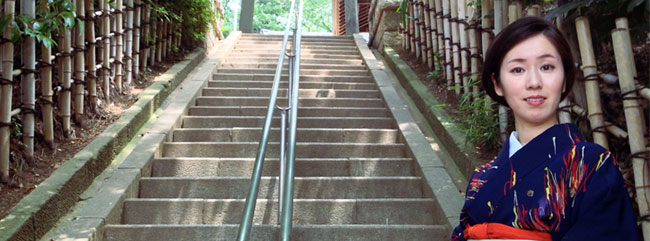
- Sawako Hashizume
-
Sawako Hashizume was born in Tokyo. She graduated from the Chuo University Faculty of Policy Studies in 2006 and then she entered The Japan School of Acupuncture/Moxibustion and Physiotherapy, where she acquired national certification as an acupuncturist and shiatsu therapist. She founded the acupuncture clinic Yojigendo in 2011. While working as an acupuncturist, she wrote articles for women’s magazines and health magazines to introduce health management techniques using everyday items. In June 2014, she published Frozen Konjac Diet. Since then, she has worked to use frozen konjac in creating and conveying health recipes which incorporate foreign food culture from countries such as the United States.
http://sawakohashizume.com/

- Research Activities as a Member of Research Fellowship for Young Scientists (DC1), Japan Society for the Promotion of Science (JSPS) Shuma Tsurumi
- Important Factors for Innovation in Payment Services Nobuhiko Sugiura
- Beyond the Concepts of Fellow Citizens and Foreigners— To Achieve SDGs Goal 10 “Reduce Inequality Within and Among Countries” Rika Lee
- Diary of Struggles in Cambodia Fumie Fukuoka
- How Can We Measure Learning Ability?
—Analysis of a Competency Self-Assessment Questionnaire— Yu Saito / Yoko Neha - The Making of the Movie Kirakira Megane








